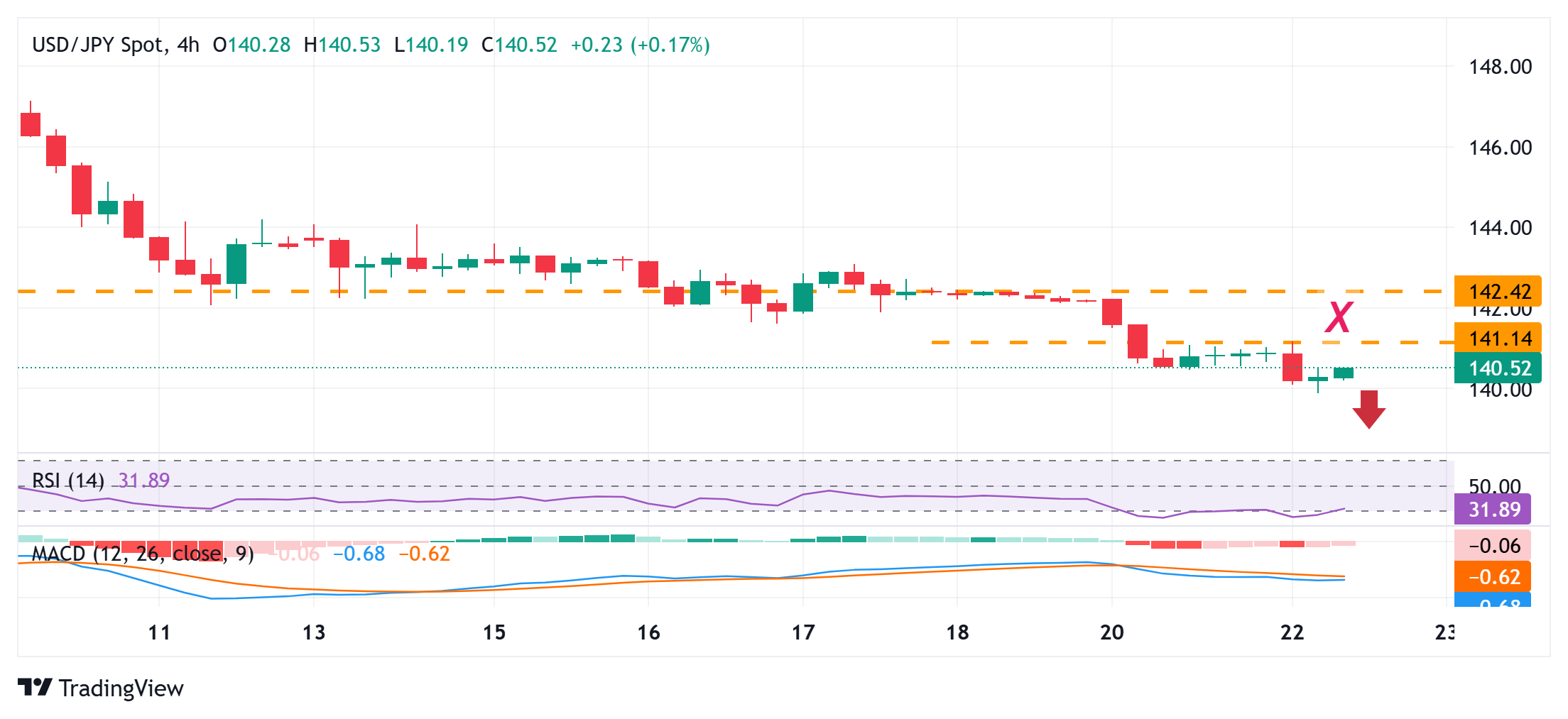- USD/JPY drops to a fresh multi-month low and is pressured by a combination of factors.
- Trade-related uncertainties and BoJ rate hike bets boost demand for the safe-haven JPY.
- Trump’s threat to the Fed’s independence weighs on the USD and contributes to the fall.
The USD/JPY pair attracted sellers for the third successive day and touched a fresh low since September 2024 – levels below the 140.00 psychological mark – earlier this Tuesday. The Japanese Yen (JPY) continues to attract safe-haven flows amid persistent trade-related uncertainties, which, along with the underlying bearish sentiment surrounding the US Dollar (USD), exerts heavy pressure on the currency pair.
Investors remain on the edge amid the uncertainty over US President Donald Trump’s aggressive tariffs, which could disrupt global trade. Moreover, worries that an all-out trade war between the US and China – the world’s two largest economies – could push the world economy into a recession have negatively impacted the market sentiment, which continues to benefit the traditional safe-haven JPY.
Meanwhile, the Bank of Japan is reportedly planning to signal next week that there is almost no need to change its basic stance on raising interest rates as the potential impact of increased US tariffs will not disrupt the ongoing cycle of wage growth and inflation. This comes on top of data released last Friday, which showed that Japan’s core inflation accelerated in March and left the door open for more interest rate hikes by the BoJ.
Adding to this hopes that Japan might strike a trade deal with the US lends additional support to the JPY. In fact, the new US ambassador to Japan said on Friday that he is optimistic about a deal in the ongoing US-Japan tariff negotiations. Furthermore, Japan’s Prime Minister Shigeru Ishiba said on Sunday that he wants to make the ongoing Japan-US tariff talks a model for negotiations between the US and other countries.
However, Japan’s Economic Revitalization Minister Ryosei Akazawa said that any agreement would likely take some time as it’s difficult to say how long it will take to bridge the gap between the two sides. Akazawa added that agriculture will not be compromised to protect the auto industry in US tariff talks. Japan’s Finance Minister Katsunobu Kato will now meet US Treasury Secretary Scott Bessent later this week to discuss currency rates.
This, however, does little to dent the JPY’s bullish sentiment. The USD, on the other hand, languishes near its lowest level since April 2022 touched on Monday as Trump’s rapidly shifting stance on trade policies has weakened investors’ confidence in the US economy. Furthermore, Trump’s attack on Federal Reserve (Fed) Chair Jerome Powell raised doubts about the central bank’s independence and keeps the USD bulls on the defensive.
In fact, Trump accused Powell of not moving fast enough to bring down interest rates. Powell last week said that the central bank was not inclined to cut interest rates in the near future amid the possible inflationary pressures stemming from the new tariffs. Moreover, White House economic adviser Kevin Hassett has suggested that Trump and his team are studying if they could fire Powell before the end of his term in May 2026.
Moreover, traders have been pricing in the possibility that the Fed will resume its rate-cutting cycle soon and lower borrowing costs by one full percentage point by the end of this year, which, in turn, favors the USD bears. Moreover, this marks a big divergence in comparison to hawkish BoJ bets, supporting prospects for a further appreciation for the lower-yielding JPY and suggesting that the path of least resistance for the USD/JPY pair is to the downside.
USD/JPY daily chart

Technical Outlook
From a technical perspective, the slightly oversold daily Relative Strength Index (RSI) holds back traders from placing fresh bearish bets around the USD/JPY pair. Any meaningful recovery attempted, however, might now confront an immediate hurdle near the 140.85 region. This is followed by the 141.00 mark, above which spot prices could climb to the 141.65-141.60 horizontal support breakpoint. A sustained strength above the latter could trigger a short-covering rally and pave the way for a move beyond the 142.00 round figure, towards the next relevant hurdle near the 142.35-142.40 region.
On the flip side, bearish traders might now wait for acceptance below the 140.00 mark, or the multi-month low touched earlier today, before placing fresh bets. The USD/JPY pair might accelerate the fall towards challenging the 2024 yearly swing low, around the 139.60-139.55 region. Some follow-through selling would make spot prices vulnerable to weaken further towards the 139.00 mark en route to the 138.70 region and eventually test sub-138.00 levels.





